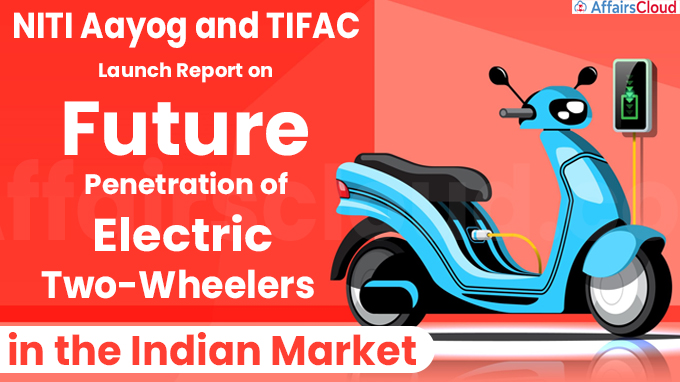
On June 28, 2022, a report titled ‘Forecasting Penetration of Electric Two-Wheelers (e-2W) in India- A Bottom-Up Analysis’ has been launched by National Institution for Transforming India (NITI) Aayog, and Technology Information Forecasting and Assessment Council (TIFAC).
Basis of Assessment:
Assumption on overall two-wheelers market volume in future years was made based on the Compound Annual Growth Rate (CAGR) of the Indian two-wheelers market since 2015.
Using a tool namely ‘Agent-based model’ made by NITI Aayog and TIFAC, 8 scenarios have been developed for analyzing the future penetration of e-2W in India which are as follows:
i.Challenged Diffusion (Where most Market Conditions are Unfavourable)
ii.Performance Driven
iii.Low Battery Cost
iv.Technology Driven
v.Incentive Driven
vi.Battery Cost Challenged
vii.Same Performance
viii.Optimistic (Favourable Market Conditions)
These future scenarios are premised upon three major factors that influence the market penetration of electric two-wheelers viz. Demand incentives; Cost of battery; and Vehicle performance in terms of both range and power.
For each of these 8 scenarios, four broad constraint levels were considered in terms of installed vehicle manufacturing capacity and available charging infrastructure –
- Full Constraint (both vehicle production and charging infrastructure are constraints),
- Production Constraint (only vehicle production capacity is constraint),
- Charge Constraint (only charging infrastructure is constraint) and
- No Constraint.
Key Highlights:
i.In an optimistic scenario, the report forecasts 100% penetration of electric two-wheelers in the Indian market by FY 2026–27.
- The projected sales of two-wheelers in the country could surge to 2.2 Cr units annually by FY31 under this scenario.
ii.In Technology Driven scenario, where current incentives are withdrawn by 2024, there will be 72% penetration by 2031.
- Assumption: The above will be achieved in case R&D (Research & Development) programme manages to enhance the range and power of electric two-wheelers by 5% annually between FY 2023–24 and 2025–26, and by 10% in FY 2026–2027.
iii.In challenged diffusion scenario, a maximum market penetration of only 5.82% will be achieved by FY 2024. This will be followed by a decline due to removal of demand incentive.
Current & Future Projection of e-2W sales in India :-
i.The sale of electric two-wheelers in India may cross 220 lakh units in FY 2028–29 under the Optimistic, Same Performance and Battery Cost Challenged scenarios.
- Under the Incentive Driven scenario, the sale is expected to reach only 55 lakh units in FY 2031.
- Under the Technology-Driven scenario, the sale may reach 180 lakh units.
- If there is sufficient installed capacity of electric two-wheelers and charging infrastructure, then sale may finally reaches about 250 lakh units.
Note – Apart from above projections, higher battery costs and higher dependency on exports for EV components and subsystems may affect the enhancement of domestic manufacturing capabilities and other policy related measures.
ii.Total e-2W sales in FY 2022 stood at around 2.31 lakh units, up 460% over FY21 sales. However, its penetration was around 2% in total 2-wheelers sales.
iii.On the whole, EV penetration in India is extremely low at 0.8%, with two-wheelers contributing a mere 17% to the total sales.
How will this report be beneficial?
The report provides important insights into the required infrastructure, manufacturing capability, policies, and technology-development priorities in the area. It will act as a tool to the industry, researchers, academicians, and policymakers to analyze and respond to various scenarios.
Government Initiatives on Electric Mobility
The Central Government is trying to enhance the use of electric vehicles in India.
In 2011, the National Mission on Electric Mobility was approved and its plan, called the National Electric Mobility Mission Plan (NEMMP 2020), was released in 2013. Then in April 2015, the Faster Adoption of Manufacturing of Electric Vehicles in India (FAME India) was launched as a part of the mission.
- This scheme had three components – demand subsidy, infrastructure and R&D support.
India’s target to achieve net-zero emissions
India signed the Paris Agreement in 2015 and committed to reduce its carbon footprint by 33-35% below 2005 levels by 2030, along with increasing the share of non-fossil fuel-based electricity to 40%. This target of reducing carbon foot-print was further revised to 45% by 2030 in the COP26. During the conference the Prime Minister of India also announced that India will achieve net-zero emissions by 2070 through adopting ‘Panchamrita’, a fivefold strategy:
- India will get its non-fossil energy capacity to 500 giga-watt by 2030.
- India will meet 50 per cent of its energy requirements till 2030 with renewable Energy.
- India will reduce its projected carbon emission by one billion tonnes by 2030.
- India will reduce the carbon intensity of its economy by 45 per cent by 2030.
- India will achieve net zero by 2070.
Click Here for Official Report
Recent Related News:
i.On April 11, 2022, NITI Aayog has launched the 1st State Energy & Climate Index (SECI)-Round I April 2022 at an event chaired by Dr. Rajiv Kumar, Vice Chairman, NITI Aayog. It is based on 2019-20 data.
ii.NITI Aayog, has inked a Statement of Intent (SoI) on the Sustainable Development Goals (SDGs) with an emphasis on children with the United Nations Children’s Fund (UNICEF) India.
About Technology Information, Forecasting and Assessment Council (TIFAC):
It works under the aegis of Department of Science & Technology (DST), Ministry of Science and Technology.
Executive Director– Pradeep Srivastava
Headquarters– New Delhi, Delhi
About NITI Aayog (National Institution for Transforming India):
Establishment– 2015
CEO– Parameswaran Iyer (w.e.f. July 1, 2022)
Headquarters– New Delhi, Delhi




